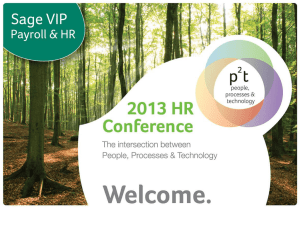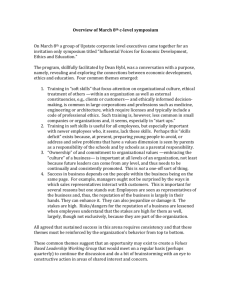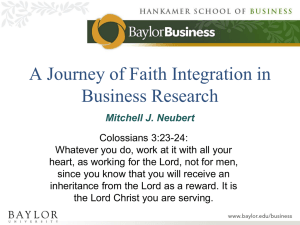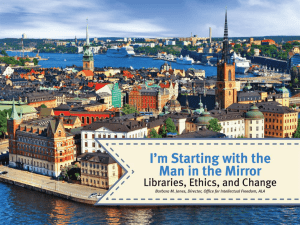Ethics in Problem Solving
advertisement
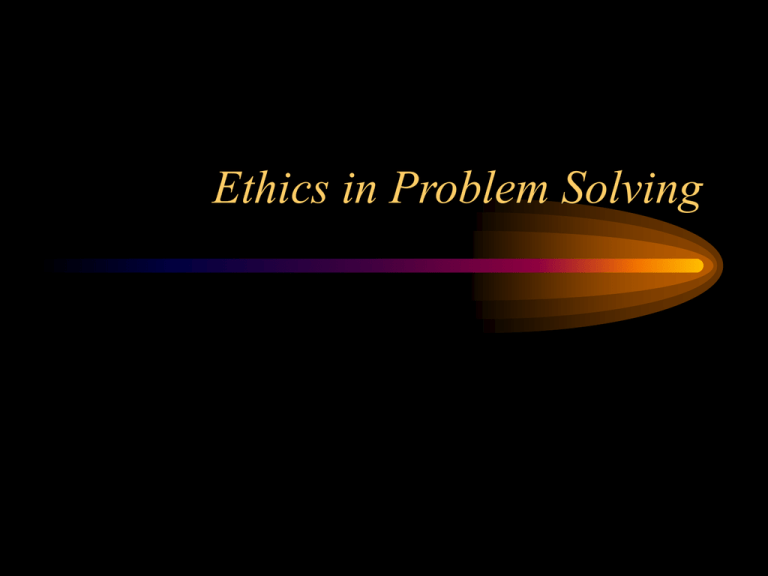
Ethics in Problem Solving Technology vs. Science • What is the difference between science and technology? • Why are they separated? • What are the impacts of technology compared to the impacts of science? • Can technology survive without science? • Can science survive without technology? Four areas where technology effects people! Technology includes impacts on yourself and others. Technology is a decision process and not just using tools. Technology is cultural. Technology deals with resource allocation. Technology includes impacts on yourself and others. • Main reason that ethics and technology must co-exist. • Agriculture – Population growth – Laws and codes – environmental problems. • Other ways? Technology is a decision process and not just using tools. • More than tools – it’s a decision process. • Technology is about solving problems that nature and our human bodies won’t. • Population increase – need to record time – time keeping device – water clocks, shadow cross bars, sand glasses, etc. Technology is cultural. • • • • Technology emerges as a cultural basis. Increases standard of living. Hand in hand with ethics of the culture. Automobile in the US. Technology deals with resource allocation. • Technology uses resources! • Appropriate technology. • Printing Press – Wow! Technology and Problem Solving Several centuries ago, a curious but deadly plague appeared in a small village in Lithuania. What was curious about this disease was its grip on its victim; as soon as a person contracted it, he or she would go into a very deep almost deathlike coma. Most individuals would die within twenty-four hours, but occasionally a hardy soul would make it back to the full bloom of health. The problem was that since early eighteenth century medical technology was not very advanced, the unaffected had quite a difficult time telling whether a victim was dead or alive. This didn't matter too much, though, because most of the people were, in fact, dead. Then one day it was discovered that someone had been buried alive. This alarmed the townspeople, so they called a town meeting to decide what should be done to prevent such a situation from happening again. After much discussion, most people agreed on the following solution. They decided to put food and water in every casket next to the body. They would even put an air hole up from the casket to the earth's surface. These procedures would be expensive, but they would be more than worthwhile if they would save some people's lives. Another group came up with a second, less expensive, right answer. They proposed implanting a twelve inch long stake in every coffin lid directly over where the victim's heart would be. Then whatever doubts there were about whether the person was dead or alive would be eliminated as soon as the coffin lid was closed. Problem solving? • What differentiated the two solutions were the questions used to find them. – First group: “What should we do in the event we bury someone alive?” – Second group: “How can we make sure everyone we bury is dead?” Innovation Tips • Always look for a second right answer. • The answers you get from a problem depends on the questions you ask. • Let your creativity flow. Ethics in Problem Solving • Which of the two decisions, made by the villagers, is the most ethical one? • How should moral and ethical judgments fit into the villagers decisions? Read your mind? • • • • • Pick a number between 1 and 9; Subtract 5; Multiply by 3; Square the number (multiply by the same number); Add the digits until you get a single digit (for example, say your number was 64: 64 = 6 + 4 = 10 = 1 + 0 = 1); • If the number is less than 5, add 5; otherwise subtract 4; • Multiply by 2; • Subtract 6; Read your mind? • Relate the number you now have with a letter in the alphabet where 1 = A, 2 = B, 3 = C and so on; • Pick the name of a country that begins with that letter; • Use the second letter of the country and think of an animal that begins with that letter; • Think of the color of the animal. • Grey Elephant from Denmark! Self tests for problem solving • Role exchange test – “shoe was on the other foot” • Universal consequences test – “what if everyone did this” • New cases test – “any other situations that are similar to this” • Subsumption test – “is this morally/ethically acceptable” Technology and Problem Solving Resolution Principles – Ends-based • Consequences / outcomes – Rule-based • Principles • Duties / rights – Care-based • Compassion • mercy – Role-based • Profession • virtues How to solve problems ethically - Get the facts - Identify the ethics involved - Prioritize the ethical issues - Apply “resolution princ.” - Recommendation - Preventative ethics Sub-Arctic Survival Simulation (TCS # 10, 12 & 13)

